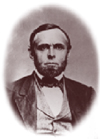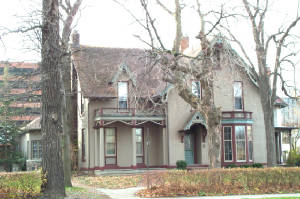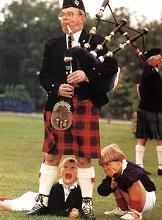|
|
 |
|

|
| Dr. Silas Douglas |
Dr. Douglas came from the University of Vermont to the University of Michigan in 1842 to be assistant to Dr. Douglass Houghton,
whose knowledge of chemistry, mineralogy and geology was of vast importance in the opening of the Michigan copper country.
For his own part Dr. Douglas soon became one of the most valued members of the university faculty. Through his efforts a chemical
laboratory, the first in the United States built for the purpose, was opened in 1857. Dr. Douglas was a pioneer in teaching
chemistry by helping the students to perform their own experiments.
|
 |
|
Dean of Medical School
Silas Hamilton Douglass, served as dean of the University of Michigan medical school from 1852-57, and later from
1862-68. Douglas had moved to Michigan from his home state of New York in 1838, and began to study medicine in the office
of Regent Pitcher. He also worked as a physician under another regent, the renowned Native American scholar Henry R. Schoolcraft.
Douglas was eager to learn about medicine, writing that “Our profession is one of a progressive character, and it requires
all our energies to keep pace with its advancement” (Silas Douglas to Helen Welles, 24 July 1843, Douglas 1, MHC, excerpt
in The Origins of Michigan’s Leadership in the Health Sciences by William Hubbard, Jr. and Nicholas H. Steneck, University
of Michigan, Ann Arbor, 1995). In 1842 he finished his medical studies at the University of Maryland in Baltimore. He moved
to Ann Arbor in 1843 to practice medicine, and his enthusiasm about the field fueled contributions to the creation of a medical
department at Michigan.
In 1847, Douglas signed, along with Abram Sager, the “memorial” written to the Regents requesting a Medical
Department. He, Sager and Zina Pitcher represented the first generation of scientists at the University of Michigan. Douglas
came to the University of Michigan in 1844 to be an assistant in chemistry without salary. Eventually uncomfortable with this
arrangement, he explained to his mentor Pitcher in 1846 that he was dissatisfied spending so much time teaching chemistry
without compensation or a regular appointment. To ensure that Douglas would stay, Pitcher saw to it that he became professor
of chemistry, mineralogy, and geology in the Department of Literature, Science & Arts. Also in 1846, Douglas became superintendent
of university buildings and grounds, overseeing the construction of several prominent buildings on campus.
In 1848, Douglas was appointed to teach pharmacy and toxicology as one of the first two faculty members in the new Medical
Department. Though his official title was professor of materia medica, he kept a small lab in the medical building and gave
chemical demonstrations before class. This was not uncommon, as many professors at this time did not necessarily teach in
their named disciplines. They often taught extra fields, and were very knowledgeable about the natural sciences and basic
chemistry. Douglas persuaded the regents to allocate money for a chemical laboratory, which was built in 1855-1856. Since
the lab was founded by Douglas, it was considered part of the Medical Department. The building’s construction was a
triumph, since it was the first university building in the country built solely for chemistry. Douglas’ greatest legacy
to the University was his work in chemistry. He published “Tables for Qualitative Chemical Analysis” (1864) with
Professor Albert B. Prescott, and “Qualitative Chemical Analysis: a Guide in the Practical Study of Chemistry”
(1874).
|
 |
|
Mayor of Ann Arbor
A problem that Ann Arbor faced in the 1850s is one that is also common today: the massive consumption of alcohol by students.
With the end of the civil war, the enrollment at the University of Michigan rose to 1,205, making it the largest university
in the nation. Rambunctious behavior was common at universities across the nation, but the citizens of Ann Arbor held themselves
up to a higher degree of behavior and such low-grade activity would not be tolerated.
The citizens in 1869, brought to the Ann Arbor City Council a petition with 1,100 signatures demanding the enforcement
of the liquor law that prohibits saloons from doing business on Sundays.
The demand for order was so great that in 1871 the citizens elected Silas Douglas as mayor.
Douglas was the first University faculty member to become mayor. His stance was that "good moral influences should
prevail in our University city." Douglas went to every business that sold alcohol and warned the owners to follow the
anti-liquor law or face prosecution. This proved to be successful because of the respect Douglas commanded. Soon, an ordinance
creating a permanent police force followed Douglas' efforts, which was funded by license fees saloons had to pay.
Construction Supervisor
In 2004, the University of Michigan celebrated the 150th anniversary of the founding of Detroit Observatory. Silas Douglas,
supervised construction of Detroit Observatory, a duty he similarly performed for several other campus construction projects.
The University selected as the site a 1.62-hectare (4-acre) hilltop located 800 m (half a mile) from the Campus, and work
commenced in 1853 and was completed the following year. The floor plan was typical of nineteenth-century observatories , consisting
of a two-story central mass topped by a revolving dome, and two one-storey wings, one for the meridian circle and the other
for the Director's office and library . The main building was 9.75 m (32 feet) square and 7.3 m (24 feet) high, with a solid
brick pier ascending through its centre into the dome above to provide a stable base for the refracting telescope. The building
was designed to avoid touching the pier. The walls of the building were solid brick covered with stucco that was scored to
resemble individual blocks of stone. Pigments were added to the wet stucco, and the resulting effect was that every scored
section was a different shade resembling granite. White and black paint was finely spattered on the stucco to resemble the
sparkles in granite, and the mortar joints were painted white. From a distance, the building appeared to be made of stone.
Observatory was nearly totally destroyed by fire in 1905.

|
| Dr. Douglass' house still stands in Ann Arbor, Mich. |
Dr Douglass'grandfather was Daniel Douglas, captain of a regiment of Connecticut Volunteers in the Revolutionary War. The
pioneer of his family in the New World was Robert Douglas, born in Scotland in 1639, who married Mary Hempstead, the first
child born in New London, Conn.
|
 |
|
|
 |
|
|
|
|
Douglas' service at the University ended in 1877, under unfortunate circumstances. A discrepancy in the accounts of the chemical
laboratory was discovered in 1875, and Assistant Professor Preston Rose was accused of taking more money from students than
he gave to Silas Douglas, his supervisor. Rose shifted the blame onto Douglas, and the affair became public and highly controversial.
The scandal was taken before the regents, and eventually both Rose and Douglas were dismissed. Although the Michigan Supreme
Court ruled in Douglas" favor when he contested the regents verdict, he was not reappointed at the University.
|
|
|
 |

